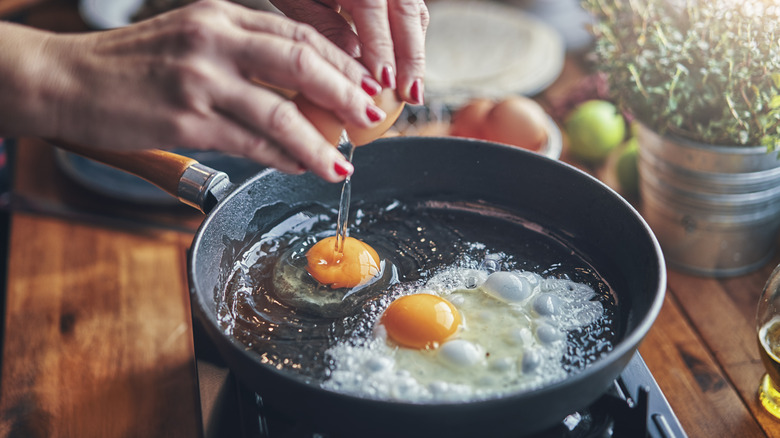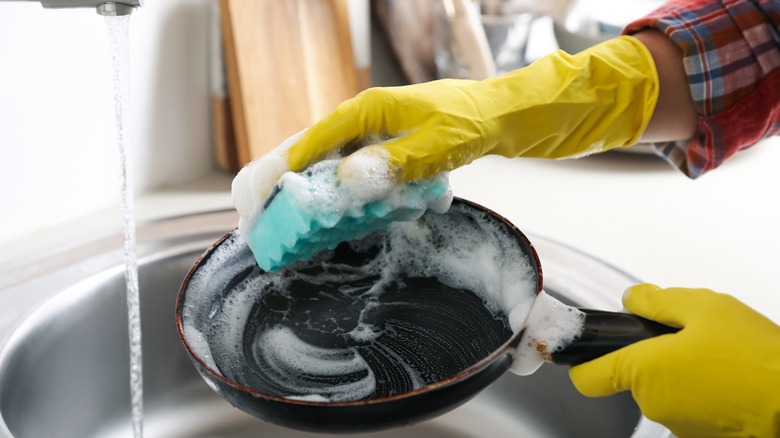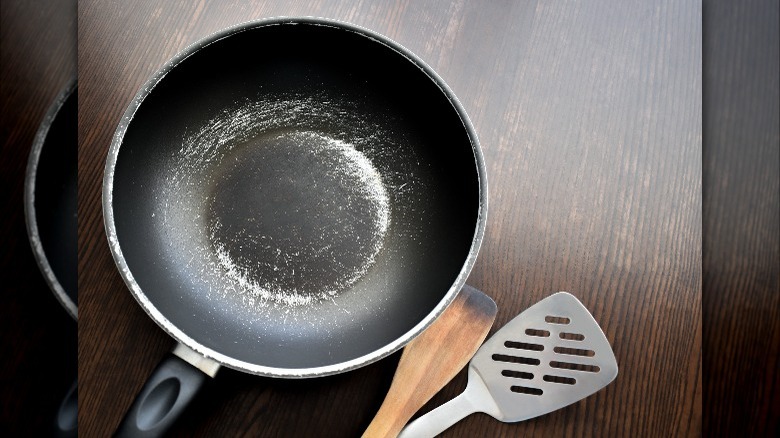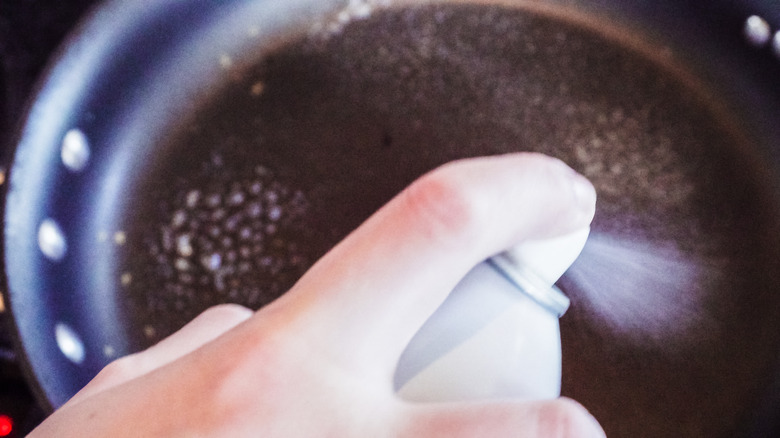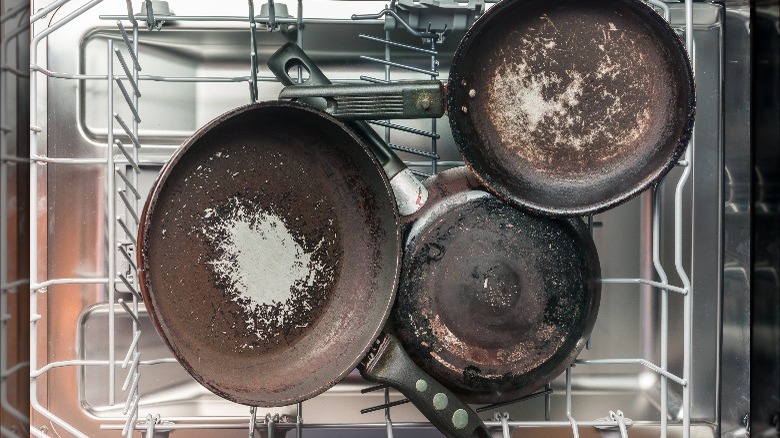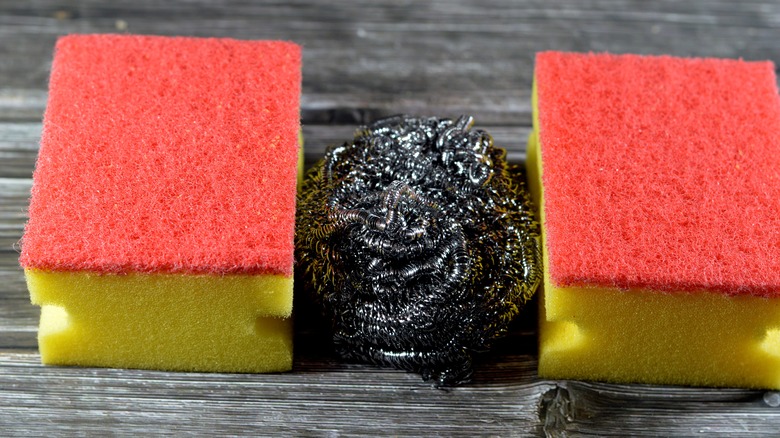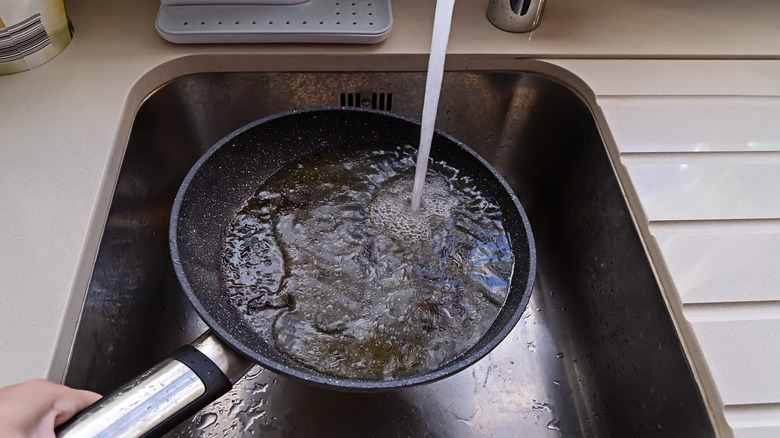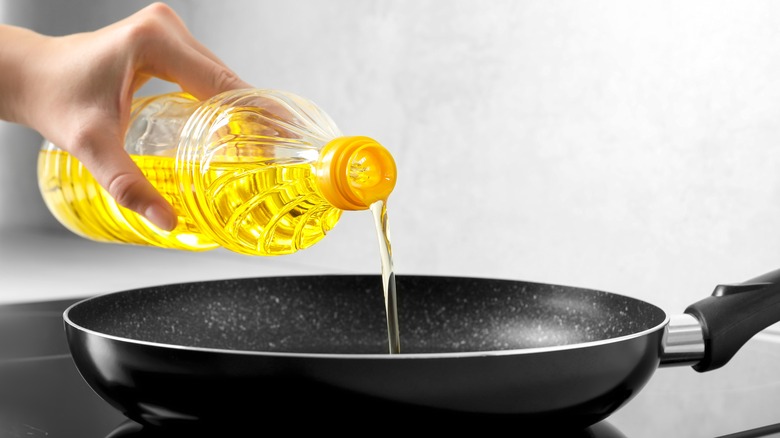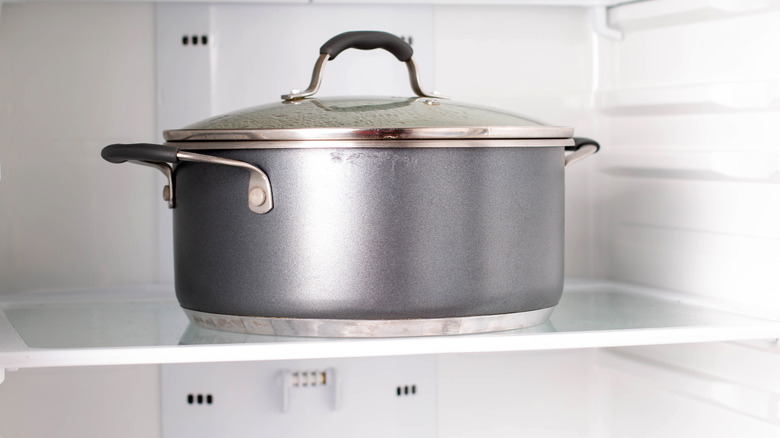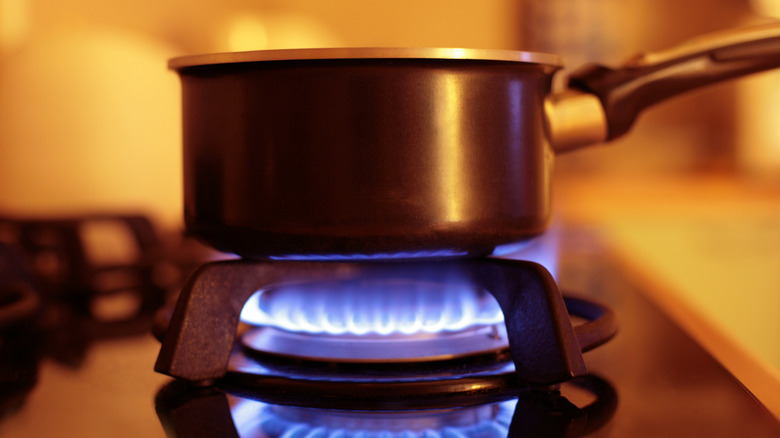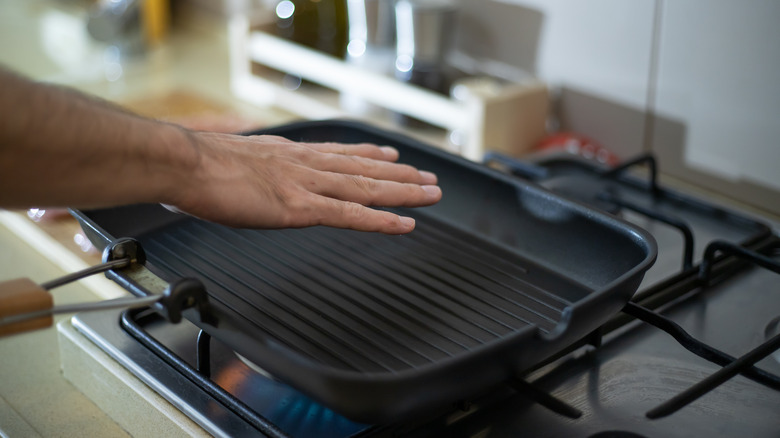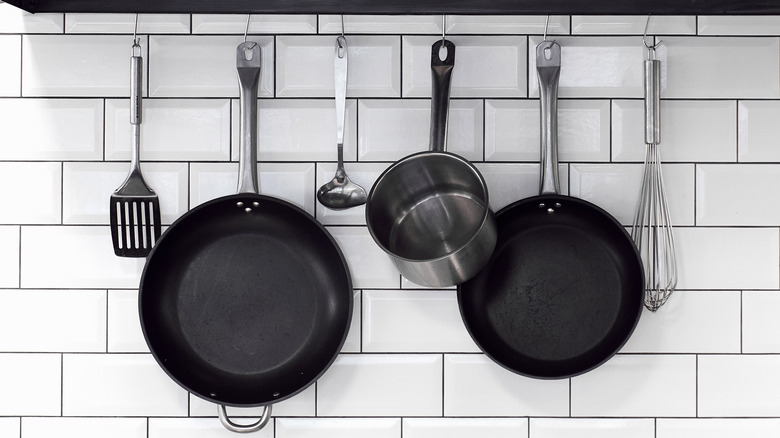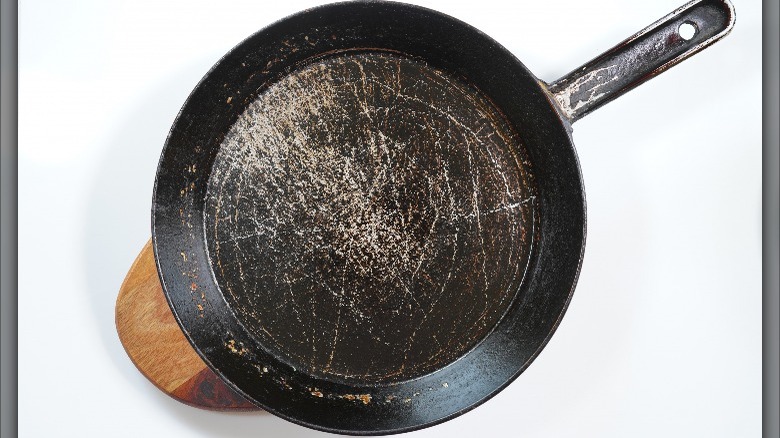12 Mistakes You Need To Stop Making With Your Nonstick Cookware
Nonstick cookware is a staple in most kitchens and it is easy to understand why. As its name suggests, nonstick cookware has a special coating that helps keep foods from sticking as they are cooking. Not only can this help ensure that your meals turn out as intended (who wants to eat burnt and stuck on rice, anyway?), but it also helps make cleaning up a breeze. You don't need to worry about soaking the cookware for hours only to end up still scrubbing those caked-on messes.
However, as wonderful as nonstick cookware is, there are several mistakes that you could be making when using it. These errors can decrease the lifespan of your pots and pans, negatively impact how your foods turn out or even threaten the health and safety of anyone eating the meals you cook. If you want to make sure you don't fall victim to these common mistakes, be sure to keep reading.
Not washing new nonstick pots or pans before using them
When you buy a new nonstick pan, you're probably excited to start using it right away. Once you've removed it from the box, you may assume that it is clean and ready to use. After all, it was wrapped in plastic, so it shouldn't need to be washed first, right? Unfortunately, this is not the case. Even if your new cookware (and other dishware) looks clean, it is still important to wash it before you plan to use it.
New kitchenware can have traces of dirt, dust, or packaging materials on it. Chances are, the new pot or pan you're excited to use has come into contact with different individuals and surfaces, any of which could have transferred various bacteria to it. You'll want to give it a good deep cleaning before cooking anything you'll be eating or feeding those you care about. Fill your sink with warm soapy water and add about ¼ cup of vinegar, which will help disinfect the cookware and make sure it is ready for use. After washing, be sure to thoroughly rinse the item to remove any vinegar or soapy residue from its surface.
Using metal utensils with your pots and pans
One of the biggest no-nos when it comes to nonstick cookware is using metal utensils. A special coating is what makes nonstick pans ... well, nonstick. When you use metal utensils with your cookware, you could inadvertently scratch or chip off the coating. As they get more scratches and chips, the nonstick pans will be less effective at keeping foods from sticking while cooking. Seriously scratched or chipped pans can also be unsafe to use, so you're risking decreasing the usable lifespan of your cookware if you use metal utensils with it.
Fortunately, there are several alternatives to metal utensils that can safely be used with nonstick pots and pans. One option is to use wooden or bamboo spoons and turners. They can work well for a variety of cooking tasks and will not scratch a nonstick finish. Silicone and nylon tools have gotten increasingly popular over the past several years, too, and they are also safe to use with nonstick cookware. And, unlike wooden or bamboo utensils, they're also dishwasher-safe and easy to clean.
Using an aerosol nonstick cooking spray
Using aerosolized cooking sprays is another mistake you will want to avoid when cooking with nonstick cookware. These nonstick cooking sprays are formulated with a compound called lecithin. When sprayed on nonstick pots and pans, the lecithin sticks to the surface and isn't fully removed even with washing. This means that over time it will build up more and more over the inside of your cookware. This can lead to the surface of the pan losing its nonstick properties, which will result in foods sticking. Some cookware manufacturers even state that the use of cooking sprays with their products can void the warranty.
Instead of using a cooking spray, use butter or oil to coat the pan before cooking. If you like being able to spray your pots and pans, you can find oil misters in stores and online. These misters are not aerosolized and allow you to use your preferred type of cooking oil.
Washing them in the dishwasher
The best way to clean your nonstick cookware is by handwashing it. Many brands have special PTFE (polytetrafluoroethylene) coatings. Commonly known as Teflon, this synthetic coating should not be cleaned in the dishwasher. The harsh and abrasive dishwasher detergents can break the coating down, which can cause it to start to peel. Cleaning your cookware in the dishwasher can also lead to more scratches or chips that are the result of other items in the load bumping into it or rubbing against it.
Fortunately, by design, nonstick cookware is easy to hand wash; you're unlikely to feel the need to try to clean it in the dishwasher. Hot water, dish soap, and a sponge or dishcloth are all you'll need to clean your cookware and get it ready to use again. In the event anything is slightly caked on the surface, just give the pot a few minutes to soak in warm, soapy water.
Cleaning them with an abrasive scrubber
While hand washing nonstick cookware is the best way to clean it, not all cleaning products are created equal. Never use any abrasive scrubbers, scouring pads, or steel wool to clean a nonstick pot or pan — abrasive scrubbers can actually scratch the finish of the surface. Over time, this can cause the finish to chip and may result in the pan losing some of its nonstick capabilities. Instead, only use a soft sponge, dishrag, or gentle cleaning brush as these materials will not damage the finish. And, as stated before, because nonstick pots and pans are easy to clean, you shouldn't need to use abrasive scrubbers anyway.
In the event that food gets burnt on your pan and isn't easily removed with just a soft sponge, put the pan back on the burner and add one cup of vinegar to it. Set the burner to medium heat, and bring the vinegar to a simmer. As the vinegar heats up, gently rub the bottom of the pan using a wooden spoon or nylon scraper. The vinegar and light agitation will work to loosen the burnt-on messes. Once the food is cleared from the bottom, take the pan off of the heat and allow it to cool fully, then wash it again using warm soapy water.
Cleaning a pan before it has cooled
Always let your nonstick cookware cool before washing it. While it may be tempting to clean the pan right away so you can move on to the more exciting things on your to-do list, placing a hot pan under the water is never a good idea. When you place a hot pan in water, particularly cooler water, thermal shock can occur. If the water temperature is cooler than the pan (which is likely very hot after just coming off of the burner), the temperature difference can cause the pan to warp, or possibly even crack.
When cookware warps, even slightly, it can impact its ability to sit flat on the stove. If one side of the bottom of the pan is just a bit higher than the other, the food won't cook evenly. To avoid this potentially disastrous consequence, always remove your pan from the burner and let it cool to room temperature before you try to wash it.
Not seasoning the pan
You may have heard that you're supposed to season a cast-iron pan, but did you know that you should also be seasoning your nonstick cookware? The coating of a nonstick pan has tiny pores and imperfections and these little pits can negatively impact the pan's ability to cook the foods you want. Taking a few minutes to season your pan before using it will fill in the pores to provide a more even cooking surface. This process also helps to create a coating over the nonstick finish, which can help it last longer to ensure that the pan remains nonstick.
Most nonstick pans should be seasoned a few times each year. However, be sure to check the specific recommendations from the manufacturer of your cookware, as some recommend following a more frequent seasoning schedule. Fortunately, it is not difficult to season a nonstick pan. After washing your new pan and drying it fully, pour about one tablespoon of canola oil into it. Move the pan around to coat the entire surface with the oil, then place it on a burner set to medium heat. Give it about one minute to heat up over the burner, then remove it from the heat and allow the oil to dry. Wipe off the excess once the pan is cool and mostly dry.
Storing food in a nonstick pan
Have you ever made a big pot of chicken noodle soup and just decided to store the extra in the nonstick stock pot in the fridge? If so, then you've been making a mistake. Storing food in your nonstick cookware can be bad for both the cookware and the food you're storing in it. First, food that is acidic can cause the pan's coating to break down, making it more likely for things to stick when you cook. Plus, when you leave food in the cookware for several hours in the fridge, it can pick up different flavors. You may notice that items have an unpleasant metallic taste.
While it may take a few extra minutes to transfer leftovers from your cookware into a storage container, it is the right choice. You'll be happy when your foods don't have an off-putting flavor and you don't have to replace your cookware earlier than anticipated because of improper use.
Cooking over high heat
Some types of cookware, such as stainless steel and cast iron, are well-suited for use over high heat. However, the same is not true for nonstick pots and pans. You should avoid placing them over a burner set too high and should opt for a different type of cookware for recipes that call for searing meats and other similar tasks.
The reason you want to stay away from high heat when you're cooking with nonstick pans is because of how they're made. The coating over a nonstick pan that is responsible for making it nonstick actually has several small pits and divots. To prevent these divots from clamping down on food as the hot metal pan expands from exposure to the heat, manufacturers add a second coating over the pan.
This coating, made from frozen and compressed gas, has a waxy texture. If it is exposed to temperatures that are too high, it can degrade. In addition to the negative impact on the nonstick surface of the pan, when the coating degrades it can actually release fluorocarbons into the home's air, which may cause respiratory problems.
Preheating the pan while it is empty
Preheating an empty nonstick pan is not a good idea. The reason behind this ties to what we explained above about the importance of not cooking over high heat with a nonstick pan. When an empty pan is placed over a burner, even on a lower heat, it is going to heat up very quickly. If the pan gets too hot, it can lead to the same problems described above with the coating breaking down or toxins being released into the air. When using a nonstick pan, you should always add your fat (such as butter or oil) before you turn on the burner.
Similarly, you shouldn't preheat your nonstick cookware for very long. 30 seconds should be long enough to get the pan hot and ready to use, but not so long that you're risking the pan getting dangerously hot. And, remember, never preheat nonstick pans over high heat. Moderate heat is sufficient for this type of cookware.
Not storing them properly
If the surface of a nonstick pan gets scratched or dinged, it can negatively impact the pan's nonstick properties. As noted above, it can also decrease the pan's lifespan. This is why using metal utensils with this type of cookware is not a good idea, but that isn't the only way you can scratch the pots and pans. If they aren't stored properly, the coating can also get scratched or nicked, making the pan less effective.
In a perfect world, you'd have plenty of room in your cabinets to space out your pans and leave them in a single layer. However, it is unlikely that your kitchen has sufficient space for this to be a reality. If you need to stack your cookware to get it to fit in your cabinets, make sure you place a dish towel or padded cookware protector between each piece. This will prevent the bottom of one pan from scratching or dinging the finish of the one beneath it.
Also, take care to avoid storing your cookware near knives or other sharp and or hard cooking tools. You could also hang nonstick cookware from a ceiling rack if the space in your kitchen allows for one. Just make sure that the pots and pans are not hanging too close to each other so that they could rub against one another.
Not knowing when it is time to replace the pans
One mistake that many people make with their nonstick pans is continuing to use them when they really should be replaced. As mentioned earlier, scratched or nicked pans can be unsafe to use. If the pan is scratched, then it is possible for some of the particles from the coating (especially coatings made from PFAS) to be released into the foods you cook in them. Because the chemicals used to make some nonstick coatings are potentially hazardous — and it isn't always easy to distinguish safer options from ones that are less safe — it is best to avoid cooking with scratched cookware.
Similarly, even if your nonstick pan appears to be scratch free, it could also be time to replace it if the once nonstick surface is no longer very nonstick. A loss of effectiveness can indicate that the coating over the pan has started to deteriorate, which can also make it less safe to use. If you have any questions about the safety of your nonstick cookware, it is better to be safe than sorry and purchase a replacement set.
